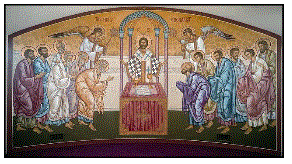In the last issue of this article I began sharing with you how St John Chrysostom explains the meaning of the Divine Liturgy. He actually used several different ways. The first way is based on the belief that all the events in the life of Jesus were, in actuality, prefigured in the Old Testament (e.g., Jesus’ resurrection is the same as the Exodus and Jesus is the new Moses). Therefore the Divine Liturgy has to reflect this also.
The second way that John used was allegory. This allegorical interpretation of the Liturgy seems to have originated in the region of Antioch, an important early site of Christianity. Theodore of Mopsuestia gave us the first allegorical explanation of the Liturgy in his Catechetical Homilies. For him the Liturgy is the image of heavenly realities and the memorial of the historical life of Jesus. John used both approaches as a means of encouraging Christians to become truly involved in the Liturgy. It is not meant to be simply observed. It is a series of ritual actions which are meant to involve a whole community in the worship of God.
 I would hasten to point out that perhaps it does not really matter how we interpret the meaning of the Divine Liturgy if we realize that it is more important for us to see the Liturgy as our personal way to join with Jesus and others in offering glory, honor and worship to God. The true value of the Liturgy comes when we see that it is our symbolic way of offering our very lives, as Jesus did, to God in thanksgiving for the very gift of life. This is based on the fact that the Church came to realize that what Jesus revealed was a new way of offering praise and worship to God that is by the offering of self, symbolically, to God. The offering of self, represented by that which supports life, namely food, was instituted by Jesus at the Last Supper.
I would hasten to point out that perhaps it does not really matter how we interpret the meaning of the Divine Liturgy if we realize that it is more important for us to see the Liturgy as our personal way to join with Jesus and others in offering glory, honor and worship to God. The true value of the Liturgy comes when we see that it is our symbolic way of offering our very lives, as Jesus did, to God in thanksgiving for the very gift of life. This is based on the fact that the Church came to realize that what Jesus revealed was a new way of offering praise and worship to God that is by the offering of self, symbolically, to God. The offering of self, represented by that which supports life, namely food, was instituted by Jesus at the Last Supper.
Prior to Jesus’ actions, people thought that the way to worship God was to take something they owned (typically it had to be the best of whatever they owned) and then destroy so that no one by God might possess it. There wasn’t the thought that they could symbolically offer themselves to God in thanksgiving for the gift of life. This was probably due to the fact that they did not think that human life was, in some mysterious and mystical way, a sharing in God’s own life.
In order to truly accomplish the worship of God through the Divine Liturgy, we must personally find a way to think about the Divine Liturgy so that we are a part of it. This is why I have repeatedly encouraged people of thinking about the bread and wine (food) as representing them, together with Jesus. Remember, we worship the Father as Jesus did. This attitude and way of thinking brings us into union-with (communion) with God. The Liturgy then reminds us that when we think this way, God returns life to us with His blessings.
